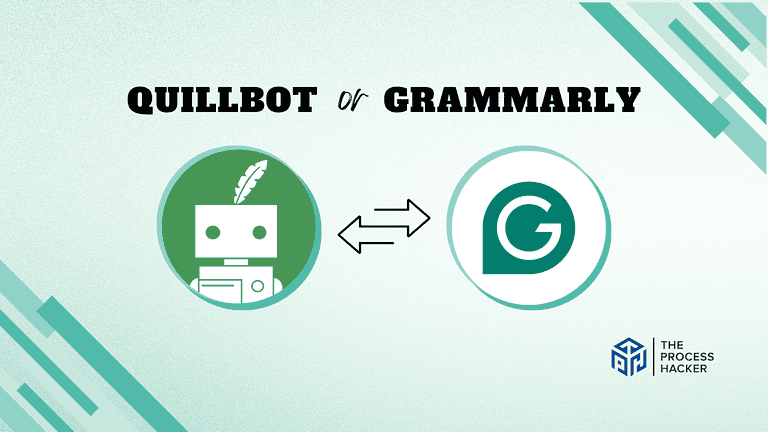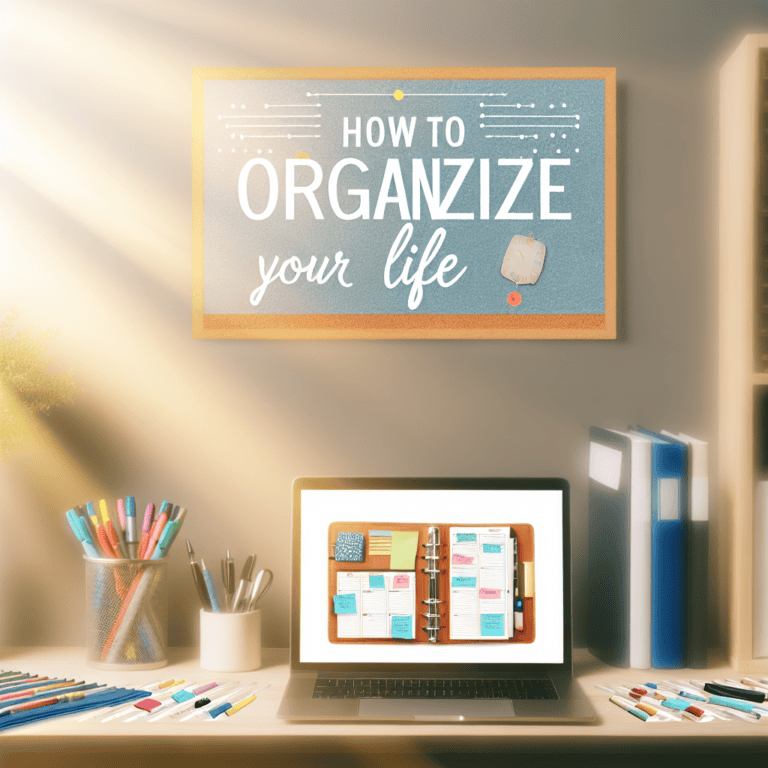Getting Things Done by David Allen | Book Summary
“Getting things done requires two basic components: defining (1) what “done” means (outcome) and (2) what “doing” looks like (action).”
David Allen, Getting Things Done: The Art of Stress-free Productivity
When it comes to productivity and efficiency, David Allen is one of the top five executive coaches in the world, and his work is renowned worldwide. His #1 New York Times best-selling book, Getting Things Done, has been heralded by professionals as an effective system for achieving stress-free productivity, managing life, and improving workflow.
In this Getting Things Done summary, we’ll take a look at the core principles behind Getting Things Done so you, too, can learn how to bring more organization into your daily activities, deepening your understanding of workplace optimization.
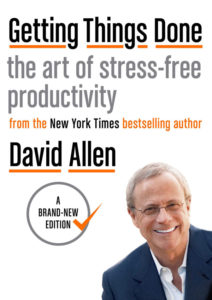
Buy Getting Things Done on Amazon
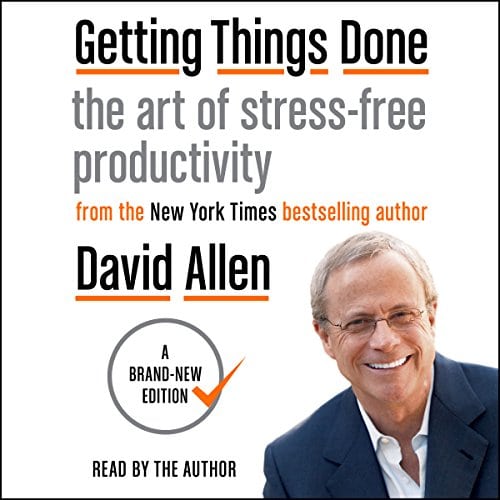
Getting Things Done by David Allen
The Art of Stress-Free Productivity
As one of the best productivity books out there, Getting Things Done: The Art of Stress-Free Productivity is about David Allen’s personal productivity methodology that transforms the way you approach your personal and professional life. The Getting Things Done (GTD) method helps you organize your calendar, tasks, and priorities such that your work is manageable.
As a bottom-up method, the advantage of the Getting Things Done system is that you know what you are currently working on and what you plan on doing next. The GTD system helps you move the same thought or negative feelings out of your head and into your system to channel your mental energy into your work.
Download The PDF Book Summary For Getting Things Done by David Allen
Part 1: The Art Of Getting Things Done
In the first part of Getting Things Done, David Allen overviews the GTD productivity system and explains what makes it unique, timely, and functional.
Chapter 1: A New Practice For A New Reality

Three Key Objectives For Getting Things Done
- Capture everything that may need to be done or valuable in an organized, trusted system out of your head.
- Make front-end decisions about your “inputs” to create an inventory of “next actions” that can be implemented or changed.
- Curate and coordinate all of that work among the commitments that you have with yourself and others.
Four P’s Of The Methodology
- Problem: “People have enhanced quality of life, but at the same time, they are adding to their stress levels by taking on more than they have resources to handle.”
- Promise: You will get things done and perform at the highest levels while feeling calm, highly focused, and efficient with work.
- Principle: “Most stress experienced comes from inappropriately managed commitments they make or accept.”
- Process: “The key to managing all your stuff is managing your actions,” not your time, information, or priorities.
Requirements For Managing Commitments
- Get it out of your mind. Anything considered unfinished should be captured in a collection tool or a trusted system outside your brain to come back to regularly and sort through.
- Clarify what your commitment is and decide what actions you will take to make progress toward fulfilling it.
- Decide what actions to take next and keep reminders of them organized in a system you regularly review.
Open Loops
The “open loops” must be adequately controlled:
Open Loop – anything that does not belong where it is, the way it is, will pull on your attention if it’s not appropriately managed;
The Open Loops are controlled either:
- Horizontally – maintains control across all the activities in which you are involved; on the order of the day-to-day activities
- Vertically – manages thinking, development, and coordination of individual topics and projects; on the order of larger goals
Chapter 2: Getting Control of Your Life: The Five Stages Of Mastering Workflow
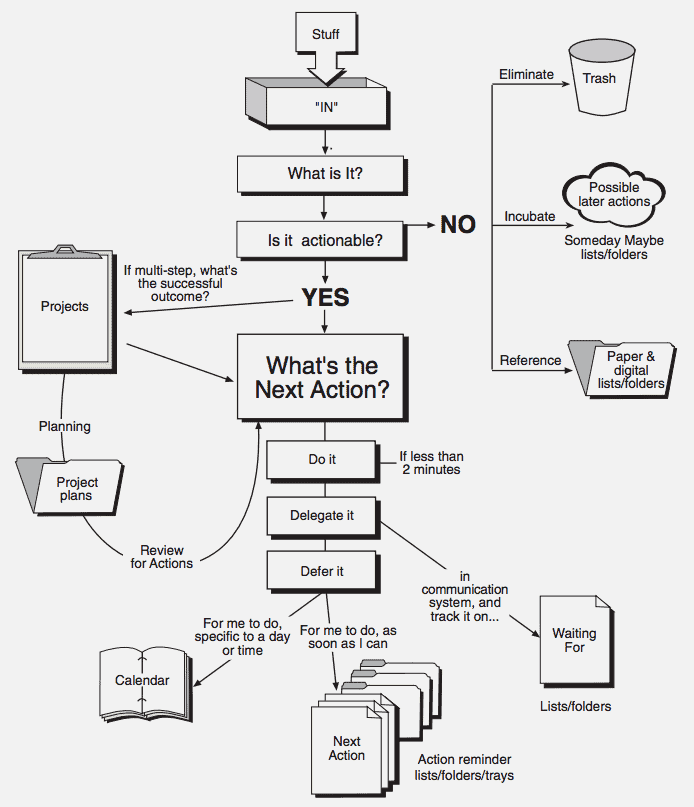
There is a horizontal five-step method for managing your workflow:
- Capture what has your attention. Write, record, or gather these things into your collection buckets.
- Clarify what each item means and put it where it belongs. Decide if the thing is actionable to determine the next action or not actionable to delete, defer, or store it.
- Organize the results to focus on higher-level thinking. Place reminders of your categorized content in appropriate locations.
- Reflect on keeping your system operational. Regularly review all of your system components to regain relaxed control and focus.
- Engage in deciding what to get done. Make action decisions with clarity and confidence in your system.
Chapter 3: Getting Projects Creatively Under Way: The Five Phases Of Project Planning

The natural planning model consists of the following vertical five-step method. You utilize natural planning for your projects based on how your brain works:
- Defining Purpose and Principles:
- Purpose – This is why you are doing the project, including asking why, defining success, standardizing decision-making, and aligning resources.
- Principles – These are standards for behavior while doing a project.
- Outcome Visioning: Envision the what or the intended outcome of your project and determine what success looks like.
- Brainstorming: Random thinking of ideas to accomplish your project that occurs. You can capture using mind mapping, a graphical way to represent your ideas.
- Organizing: Arrange the actions, sequences, and priorities in your project. When mapped out, you can observe the existing categories, connections, and details.
- Identifying Next Actions: Decide what to do next in the project using your resources. This step may involve the next steps for actions or the planning process.
Download The PDF Book Summary For Getting Things Done by David Allen
Part 2: Practicing Stress-Free Productivity
In the second part of Getting Things Done, David Allen shows you how to implement the GTD System. It’s your personalized coaching, step by step, on the detailed application of the models.
Chapter 4: Getting Started: Set Up The Time, Space, And Tools
When we put the right things in our focus at the right time, we become more efficient. You should get the time, space, and tools to make the Getting Things Done system functional.
Time
In Getting Things Done, David Allen suggests that you schedule non-negotiable time for this process of about two whole days, preferably on a weekend or holiday in the next few weeks. This time should be deep work being uninterrupted and focused.
Space
Choose a physical workspace that is dedicated, individual, and self-contained at home, work, and even in transit. You should have enough space for a writing surface and tools.
Tools
Implement the method using the following:
- Basic Processing Tools include at least three paper trays, letter paper, writing utensils, sticky notes, paper clips, stapler, tape, rubber bands, automatic labelers, and trash bin.
- Organizers could be used to help you create and manage lists. Consulting time management books can offer additional strategies and insights to enhance productivity and organization skills.
- Filing Systems provide an excellent way to manage your reference files that are fast, functional, and fun to capture. You should organize the system alphanumerically to make it easy to add files and folders, label appropriately, and store all your stuff. Also, you should regularly go through and trash irrelevant or outdated items or files.
Chapter 5: Capturing: Corralling Your “Stuff”

When we capture everything that has our attention, we will have control, be present, and focus on the most critical work. Successful capture involves the following:
- Contain your open loops in your capture system and out of your head.
- Have as few capturing buckets as required.
- Empty your capturing buckets regularly.
We want to gather these things in one location or “in” bucket. There are two basic components to the collection process:
Physical Gathering
Physical Gathering – the action of collecting all the physical things into your physical “in” basket that is out of place in your environment
- Keep frequently-used supplies, reference files, materials, decorations, and equipment.
- Issues that you may experience include:
- Too Big: Describe the item on a piece of paper, date it, and add it to the “in” tray.
- Too Much: Create stacks around the “in” tray.
- Junk: Go ahead and throw the item out immediately.
- Locations include your desktop, desk drawers, countertops, cabinets, floors, walls, bookshelves, equipment, furniture, etc.
- Digital Items like downloaded files, emails, or voice recording devices can be printed out and added to your “in” bucket.
Mental Gathering
Mental Gathering – the action of clearing your mind of what has your attention
- Capture each thought, idea, project, or thing that has your attention separately on paper or in a digital application.
- Trigger List: David Allen includes a list to help you remember something that you forgot.
Chapter 6: Clarifying: Getting “In” To Empty

We do not want to keep anything in the “in” bucket for an indefinite period of time. Thus, we will process the “in” bucket and log the action steps in a personal reminder system either digitally or in a notebook.
Processing Guidelines
- Process the top item first. Everything gets processed equally as “process” does not mean “spend time on.”
- Process one item at a time. The focus on one thing forces the attention required to decide on the action steps.
- Never put anything back into “in.” Decide what to do with an item so you do not use the processing station as a storage bin.
What’s The Next Action?
- Non-Actionable: No action may be taken.
- Trash: Remove the items that are unnecessary, useless, or accessible from the Internet or other sources.
- Incubation Items: Defer action by writing these items on a “Someday/Maybe” list, creating a calendar reminder, or holding them in a “Pending” file.
- Reference Material: File these items in workable filing reference systems, either in physical storage or digital applications.
- Actionable: Plan and determine the very next physical action required to get you to decide on the next action.
- Do It if the action takes less than two minutes. The two-minute rule is an extremely efficient hack, as it would take longer to store and track the item in a tracking system vice taking immediate action.
- Delegate It if you’re not the most appropriate person to take action. As a leader, you can email, send notes, text, or discuss the item with the appropriate person.
- Defer It into your organization system as an option for work to do it later. Write down these actions and add these to the “Pending” file to be organized later.
Projects
Project – any outcome you are committed to achieving that will take more than one action step to complete
- Track on a “Projects” List to ensure that there are placeholders for all the open loops.
- Start Finishing: Check out our summary of Start Finishing to tackle pending projects.
Download The PDF Book Summary For Getting Things Done by David Allen
Chapter 7: Organizing: Setting Up The Right Buckets

“What does it mean to you?” Being organized means where an item is located matches what it means to you. The Getting Things Done organization allows you to reduce your cognitive load and focus your mind on higher-level thinking.
For organization, all you need are lists and folders:
- Lists – keep track of the total inventory of active commitments, including active tasks, active projects, someday/maybes, and next actions.
- Folders – list reference material and support up-to-date information for an active project.
There are seven categories of organization that should be kept distinct from one another to promote clarity.
Actionable Organization
- Calendar Actions and Information: Contains actions that must be done on a specific day, at a particular time, and/or as soon as possible. The calendar, especially when color-coded, shows your committed time blocks around which you can do the rest of your actions.
- Next Actions List: Tracks those actions that must be done as soon as possible. This list should be organized by the context required for the action, such as tools, locations, or situations. You can use the original item, like a paper or email, as its own action reminder.
- Waiting For List: Tracks actions or deliverables for other people to remind you what you are waiting for and from whom. This list is helpful when meeting with anyone that needs to provide you with deliverables.
Project Organization
- Projects List: Indexes your open loops to provide you with a complete review to ensure that all action steps have been defined for all of your projects. This list will help you gain control and focus, relieve pressure, conduct your weekly review, and manage relationships.
- Project Support Material: Supports your actions and ideas about your projects but does not remind you what to do. You can handle them either digitally in note, email, or database applications or physically in files or notebooks.
Non-Actionable Organization
- Reference Material: Systematizes into a simple library of reference files that are easily retrievable. You must decide how much to keep given your needs or preferences and organize by general reference, broad category, contacts manager, or library.
- Someday/Maybe List: Contains the projects, skills, experiences, and ideas that you want to do in the near future that is not urgent enough to do right away. This category unleashes your creativity to imagine cool ideas without committing to them.
Checklists
Checklists – the recipe for projects, work processes and procedures, events, and areas of value, interest, and responsibility; provide the items to check or review to make sure that you are not missing something
Chapter 8: Reflecting: Keeping It All Fresh and Functional
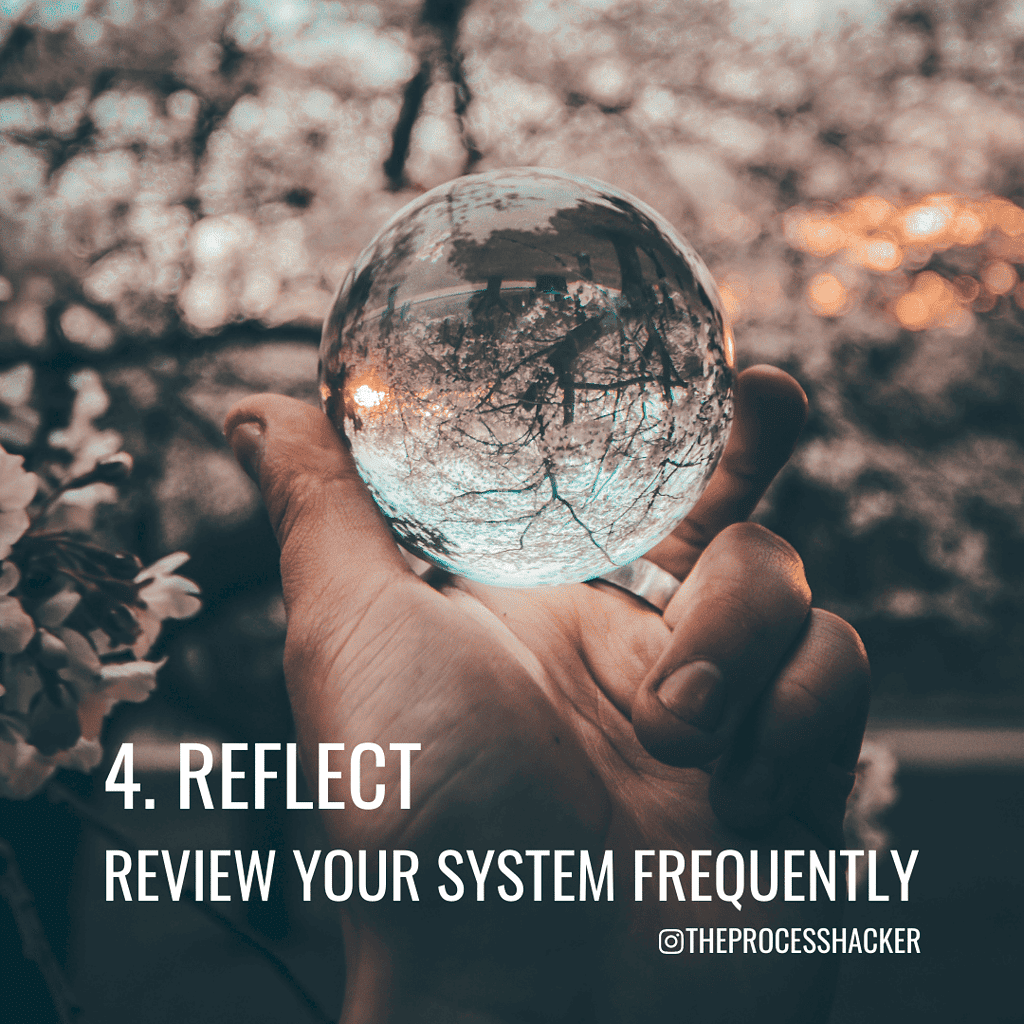
After organizing your system, a review process will allow you to operate and maintain your system. It will help you have a focused and proactive mindset about getting things done. Reflection will handle two significant issues:
What Do You Look At In All This, And When?
Daily Review – the process of checking the following:
- Calendar: Review and handle your day-specific and time-specific commitments.
- Next Actions List: Review possible actions you could take in your current context, given your location, circumstance, or when with your boss or partner.
What Do You Need To Do, And How Often?
These more extensive reviews, including a weekly review, will ensure that all of it works as a consistent system, freeing you to think and manage at a higher level.
Weekly Review – the process of workflow management includes capturing, clarifying, organizing, and reviewing all your outstanding commitments, intentions, and inclinations:
- Get Clear: Process all of your collected notes, paperwork, emails, thoughts, etc.
- Get Current: Review your orienting to-do lists and then update and complete them.
- Get Creative: Automatic generation of ideas and points of view that add value.
“Bigger Picture” Reviews – the process of clarifying the vision, values, and broader objectives that influence, challenge, and prioritize your decisions
Chapter 9: Engaging: Make The Best Action Choices

First, trust your intuition when deciding what to do at any given point. Also, three decision-making models will help you in getting things done:
Four-Criteria Model For Choosing Actions In The Moment
This model discusses the work you should do right now:
- Context: Sort your lists by context (location or tools) to prevent you from questioning what to work on.
- Time Available: Using your calendar and watch, you can match your actions with the time periods you have.
- Energy Available: Keep an inventory of tasks that need to be done with little mental or creative effort.
- Priority: Make conscious decisions based on your responsibilities, relationships, goals, and values.
Threefold Model For Evaluating Daily Work
This model discusses the work you do throughout the day:
- Doing predefined work that comes from your action lists.
- Doing work as it shows up that was not initially planned for. You can review your predefined work to figure out where you can fit in this unexpected work.
- Defining the work that comes in from your inputs to figure out what needs to be done with them at the moment or later.
Six-Level Model For Reviewing Your Work
Practically, you should review from the bottom up to start with the details and elevate the focus from there. You want to evaluate whether what you’re doing aligns with your priorities.
- Ground: The Current Actions are listed on your action lists to understand your immediate priorities.
- Horizon 1: The Current Projects are listed on your Projects list, each with objective outcomes and next actions.
- Horizon 2: The Areas of Focus and Accountability are your responsibilities both professionally at work and personally with your family, community, and yourself.
- Horizon 3: The One- to Two-year Goals are the short-term goals for your job.
- Horizon 4: The Long-term Visions are the mid-term vision for your career and personal net worth.
- Horizon 5: Life is your life-long purpose and how to maximize your expression and impact.
Chapter 10: Getting Projects Under Control
After learning the horizontal methods for Getting Things Done, this chapter helps you vertically plan your current projects. There are several tips to help you plan naturally and informally to foster creativity.
Planning Projects
There are two types of projects that need some planning activity:
- Those that still have your attention even after figuring out the next actions. These projects require the natural planning steps of brainstorming and organizing, setting up meetings, and gathering information.
- Those that may have unexpected practical ideas and supportive detail. These projects need a place for the ideas to be captured and processed later.
Tools And Structures
You need to have great tools to capture the random ideas that show up:
- Thinking Tools: Using organization applications can trigger great ideas.
- Writing Instruments: Having these around will quickly help you capture thoughts.
- Support Structures: Capture and organize your project thinking within files, notebooks, digital applications, etc.
Download The PDF Book Summary For Getting Things Done by David Allen
Part 3: The Power Of Key Principles

In the third part of Getting Things Done, David Allen describes the subtler and more profound results you can expect when incorporating the GTD system into your work and life.
Chapter 11: The Power of the Capturing Habit
Regarding capturing, you can feel overwhelmed with things to do, especially when you break commitments with yourself. Handle agreements with a habit as such:
- Don’t Make the Agreement: Say no, as you should only take on commitments you need or want to do.
- Complete the Agreement: Do it, as getting things done will make you feel accomplished.
- Renegotiate the Agreement: Change it, as you are not breaking agreements by changing the original terms.
Chapter 12: The Power of the Next-Action Decision
“What’s the next action?” There are several benefits to making this decision:
- Clarity: Provides what will get done, who will do it, and when it will be done.
- Accountability: Assigns who is responsible for the progress of the action.
- Productivity: Increases output when the next actions are known and done immediately.
- Empowerment: Improves self-confidence and self-esteem when you feel accomplished.
Chapter 13: The Power of the Outcome Focusing
Imagination can help people achieve their goals, as it narrows their focus and ability to execute the actions needed. When you know your why and have a vision for where you want to go, it will help you figure out what the 10X actions are to accomplish the vision.
Chapter 14: GTD and Cognitive Science
Chapter 15: The Path Of GTD Mastery
There are three tiers of Getting Things Done Mastery:
- Employ the fundamentals of managing using the Getting Things Done workflow;
- Implement a high-level and more integrated system to manage life holistically;
- Leverage skills to make space and get things done to express yourself, find meaning, and produce value for the world.
Download The PDF Book Summary For Getting Things Done by David Allen
Next Steps
When you use the power of one of the best productivity systems, you can achieve maximum efficiency. With Getting Things Done, you can create a stress-free productivity system that will help you get a hold of the work in your personal and professional life. Also, I hope you enjoyed the Getting Things Done summary in this post and are inspired to get your own copy of the book.
For more on how to get organized at work, check out this blog post. For more motivation and inspiration, check out our post on the best quotes on productivity.





